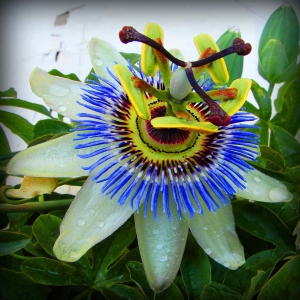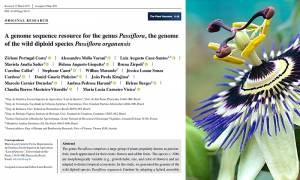
Luiz Augusto Cauz dos Santos
Arrival date : 18/06/2019
Departure date : 18/12/2019
Status : Trainee
Roles :
Last completed degree : Bachelor of Biotechnology (UFGD / Brazil)
Professional experiences :
Phylogenetic inferences in Passiflora based on the analysis of chloroplast genomes
Something went wrong when connecting to PubMed API.
Click here to access to the publication on PubMed website

Phylogenetic inferences in Passiflora based on the analysis of chloroplast genomes
Using chloroplast genome sequences (cpDNA), our research group has carried out phylogenomic analyses that resulted in strongly supported trees, providing a better understanding of the evolutionary relationships in the Malpighiales and the Fabids' clade...
Read more
The genus Passiflora consists of some 520 species, 145 of which occur in Brazil, and 83 are endemic to the country. The classical taxonomy, proposed on the basis of floral and vegetative structures, subdivided the genus into 22 subgenera. However, molecular phylogenetic analyses did not confirm that infrageneric subdivision, reducing the number of subgenera to four: Astrophea, Decaloba, Deidamioides and Passiflora, being Astrophea the more ancestral subgenus. Three clades were recognized as monophyletic (Astrophea, Decaloba, and Passiflora), but the position of Deidamioides remained unresolved, as this particular clade was found to be paraphyletic based on current data. Using chloroplast genome sequences (cpDNA), our research group has carried out phylogenomic analyses that resulted in strongly supported trees, providing a better understanding of the evolutionary relationships in the Malpighiales and the Fabids' clade. This analysis included the cpDNA of Passiflora edulis. In this context, the same approach will be applied to perform an evolutionary study in Passiflora, aiming to help to resolve the question about the status of the subgenus Deidamioides. The cpDNA of P. edulis revealed rearrangements that led to changes in the order of some genes. We suggest that these rearrangements may be associated to the infrageneric division. Moreover, the genes rpl22 and accD have been lost in P. edulis cpDNA and possibly were exported to the nucleus. We will investigate this finding, aiming to verify our hypothesis. The cp genome annotation is a crucial step, due to the presence of inverted repeat sequences and rearrangements. Therefore, we propose to use long sequence reads for generating accurate biological information to be use in the phylogenetic analyses. In this project we will perform field work aiming to collect 50 species of Passiflora, building two specimen-vouchered DNA banks: cpDNA and total DNA, and a selection of these will have their plastomes sequenced to answer the questions in a phylogenomic and evolutionary context.
Collaborators:
- Dra. Maria Lucia Carneiro Vieira (Main responsible)
Escola Superior de Agricultura "Luiz de Queiroz" /Universidade de São Paulo
Genetics Department
Avenida Pádua Dias, nº11 – Agronomia
13400-970 Piracicaba, Brasil
Phone: 55 19 3429 4442
- Dr. Cássio Van den Berg
Universidade Estadual de Feira de Santana/
Bahia ,Brazil
Publications:
Responsible CNRGV: Caroline Callot
A genome sequence resource for the genus Passiflora, the genome of the wild diploid species Passiflora organensis
Something went wrong when connecting to PubMed API.
Click here to access to the publication on PubMed website
Something went wrong when connecting to PubMed API.
Click here to access to the publication on PubMed website
Something went wrong when connecting to PubMed API.
Click here to access to the publication on PubMed website
Something went wrong when connecting to PubMed API.
Click here to access to the publication on PubMed website

